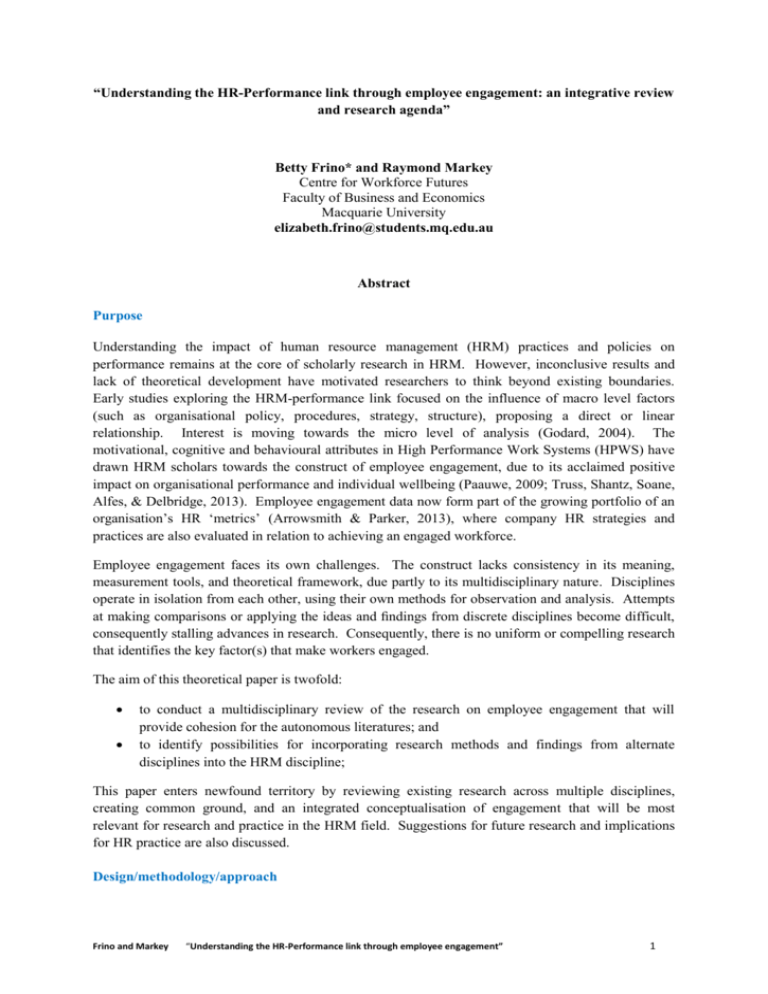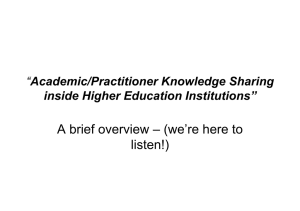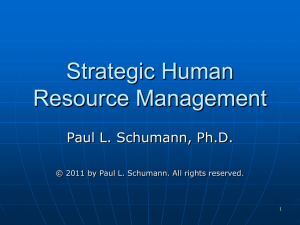Key findings
advertisement

“Understanding the HR-Performance link through employee engagement: an integrative review and research agenda” Betty Frino* and Raymond Markey Centre for Workforce Futures Faculty of Business and Economics Macquarie University elizabeth.frino@students.mq.edu.au Abstract Purpose Understanding the impact of human resource management (HRM) practices and policies on performance remains at the core of scholarly research in HRM. However, inconclusive results and lack of theoretical development have motivated researchers to think beyond existing boundaries. Early studies exploring the HRM-performance link focused on the influence of macro level factors (such as organisational policy, procedures, strategy, structure), proposing a direct or linear relationship. Interest is moving towards the micro level of analysis (Godard, 2004). The motivational, cognitive and behavioural attributes in High Performance Work Systems (HPWS) have drawn HRM scholars towards the construct of employee engagement, due to its acclaimed positive impact on organisational performance and individual wellbeing (Paauwe, 2009; Truss, Shantz, Soane, Alfes, & Delbridge, 2013). Employee engagement data now form part of the growing portfolio of an organisation’s HR ‘metrics’ (Arrowsmith & Parker, 2013), where company HR strategies and practices are also evaluated in relation to achieving an engaged workforce. Employee engagement faces its own challenges. The construct lacks consistency in its meaning, measurement tools, and theoretical framework, due partly to its multidisciplinary nature. Disciplines operate in isolation from each other, using their own methods for observation and analysis. Attempts at making comparisons or applying the ideas and findings from discrete disciplines become difficult, consequently stalling advances in research. Consequently, there is no uniform or compelling research that identifies the key factor(s) that make workers engaged. The aim of this theoretical paper is twofold: to conduct a multidisciplinary review of the research on employee engagement that will provide cohesion for the autonomous literatures; and to identify possibilities for incorporating research methods and findings from alternate disciplines into the HRM discipline; This paper enters newfound territory by reviewing existing research across multiple disciplines, creating common ground, and an integrated conceptualisation of engagement that will be most relevant for research and practice in the HRM field. Suggestions for future research and implications for HR practice are also discussed. Design/methodology/approach Frino and Markey “Understanding the HR-Performance link through employee engagement” 1 An integrative review of the engagement literature is the main method of research. The review is essential at this stage, given its multidisciplinary reach and the recent interest from HRM. Aside from Kahn’s seminal work (Kahn, 1990), research on engagement has been most prolific over the past 1015 years. The majority of the literature is grounded in the established field of Organisational Psychology (OP), with emerging inquiry from HRM scholars (Alfes, Shantz, Truss, & Soane, 2012; Arrowsmith & Parker, 2013; Robinson, Perryman, & Hayday, 2004; Truss et al., 2013). This integrative review will predominantly focus on research over this 15 year period, with a particular focus on Organisational Psychology and HRM. Attention is given to research findings and methodologies used. Key findings The review has uncovered employee engagement’s potential as the new approach to best practice HRM, providing a novel platform to inform future research on the HR-performance link (Truss et al., 2013; Wright, Gardner, & Moynihan, 2003). Its role as a mediator between HRM and performance has surfaced (see for example Alfes et al., 2012; Alfes, Truss, Soane, Rees, & Gatenby, 2013). In a similar vein, the HRM discipline has much to offer the engagement literature, through its different perspective and approach to research. The review also identified several limits of existing engagement research. Firstly, there is little evidence of cross disciplinary research. Given engagement’s multidisciplinary reach, the paper calls for more cross disciplinary research in engagement, as it has the potential to combine a range of research methods and focal points that will offer new ideas, deepen the knowledge base, and enrich our understanding of employee engagement and HRM’s role in delivering performance. Secondly, research to date is mostly quantitatively driven, relying mostly on cross-sectional survey data. Supplementing quantitative data with a qualitative and longitudinal analysis is likely to enhance engagement research. Thirdly, most studies use the individual employee as the focal point, using one single line of inquiry, with little consideration of the workplace environment or context. This is a common approach adopted by OP scholars within the engagement literature (Truss et al., 2013). This paper advocates greater emphasis on contextual factors and workplace dynamics in order to understand which (combination of) factors impact on employee engagement, and how this translates to improved performance. The HRM discipline has much to offer in this regard with its focus on issues using a broader perspective, giving more consideration to workplace dynamics, practice, policies, and output (Watson, 2010). Practical implications (if applicable) This paper advocates the need to bridge the science-practice link. This was rare in the formative years of engagement research (Welbourne, 2007). If properly constructed, research findings on engagement can inform HR policy and practice to create and operationalize engagement initiatives designed to improve performance and employee wellbeing (Macey & Schneider, 2008; Purcell, 2014; Shuck & Wollard, 2010). References Alfes, K., Shantz, A. D., Truss, C., & Soane, E. C. (2012). The link between perceived human resource management practices, engagement and employee behaviour: a moderated mediation Frino and Markey “Understanding the HR-Performance link through employee engagement” 2 model. The International Journal of Human Resource Management, 24(2), 330-51. doi: 10.1080/09585192.2012.679950 Alfes, K., Truss, C., Soane, E. C., Rees, C., & Gatenby, M. (2013). The Relationship Between Line Manager Behavior, Perceived HRM Practices, and Individual Performance: Examining the Mediating Role of Engagement. Human Resource Management, 52(6), 839-59. doi: 10.1002/hrm.21512 Arrowsmith, J., & Parker, J. (2013). The meaning of ‘employee engagement’ for the values and roles of the HRM function. The International Journal of Human Resource Management, 24(14), 2692-712. doi: 10.1080/09585192.2013.763842 Godard, J. (2004). A Critical Assessment of the High-Performance Paradigm. British Journal of Industrial Relations, 42(2), 349-78. doi: 10.1111/j.1467-8543.2004.00318.x Kahn, W. A. (1990). Psychological Conditions of Personal Engagement and Disengagement at Work. Academy of Management Journal, 33(4), 692-724. doi: 10.2307/256287 Macey, W. H., & Schneider, B. (2008). Engaged in Engagement: We Are Delighted We Did It. Industrial and Organizational Psychology, 1(1), 76-83. doi: 10.1111/j.17549434.2007.00016.x Paauwe, J. (2009). HRM and Performance: Achievements, Methodological Issues and Prospects. Journal of Management Studies, 46(1), 129-42. doi: 10.1111/j.1467-6486.2008.00809.x Purcell, J. (2014). Disengaging from engagement. Human Resource Management Journal, 24(3), 24154. doi: 10.1111/1748-8583.12046 Robinson, D., Perryman, S., & Hayday, S. (2004). The Drivers of Employee Engagement: Brighton, Institute for Employment Studies. Shuck, B., & Wollard, K. K. (2010). Employee Engagement and HRD: A Seminal Review of the Foundations. Human resource development review, 9(1), 89-110. doi: 10.1177/1534484309353560 Truss, C., Shantz, A., Soane, E., Alfes, K., & Delbridge, R. (2013). Employee engagement, organisational performance and individual well-being: exploring the evidence, developing the theory. The International Journal of Human Resource Management, 24(14), 2657-69. doi: 10.1080/09585192.2013.798921 Watson, T. J. (2010). Critical social science, pragmatism and the realities of HRM. The International Journal of Human Resource Management, 21(6), 915-31. doi: 10.1080/09585191003729374 Welbourne, T. M. (2007). EMPLOYEE ENGAGEMENT: BEYOND THE FAD AND INTO THE EXECUTIVE SUITE. Leader to Leader(Spring), 45-51. Wright, P. M., Gardner, T. M., & Moynihan, L. M. (2003). The impact of HR practices on the performance of business units. Human Resource Management Journal, 13(3), 21-36. doi: 10.1111/j.1748-8583.2003.tb00096.x Frino and Markey “Understanding the HR-Performance link through employee engagement” 3









